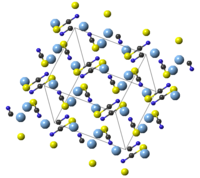Silver thiocyanate
 | |
| Names | |
|---|---|
| IUPAC name
Silver(I) thiocyanate, Silver thiocyanate
| |
| Other names
Thiocyanic acid, silver (1+) thiocyanate; Silver isothiocyanate; Silver sulphocyanide[1]
| |
| Identifiers | |
3D model (JSmol)
|
|
| ChemSpider | |
| ECHA InfoCard | 100.015.395 |
| EC Number |
|
PubChem CID
|
|
| UNII | |
| UN number | 3077 |
CompTox Dashboard (EPA)
|
|
| |
| Properties | |
| AgSCN | |
| Appearance | Colorless crystals |
| Odor | Odorless |
| Melting point | 170 °C (338 °F; 443 K) decomposes[4] |
| 0.14 mg/L (19.96 °C) 0.25 mg/L (21 °C) 6.68 mg/L (100 °C)[1] | |
Solubility product (Ksp)
|
1.03·10−12[2] |
| Solubility | Insoluble in acids (reacts)[3] except when concentrated, acetates, aq. nitrates[1] |
| Solubility in silver nitrate | 43.2 mg/L (25.2 °C, 3 nAgNO3/H2O)[1] |
| Solubility in sulfur dioxide | 14 mg/kg (0 °C)[4] |
| Solubility in methanol | 0.0022 mg/kg[4] |
| −6.18·10−5 cm3/mol[2] | |
| Structure | |
| Monoclinic, mS32 (293 K)[5] | |
| C2/c, No. 15 (293 K)[5] | |
| 2/m (293 K)[5] | |
a = 8.792(5) Å, b = 7.998(5) Å, c = 8.207(5) Å (293 K)[5] α = 90°, β = 93.75(1)°, γ = 90°
| |
Formula units (Z)
|
8 |
| Thermochemistry | |
Heat capacity (C)
|
63 J/mol·K[4] |
Std molar
entropy (S⦵298) |
131 J/mol·K[4] |
Std enthalpy of
formation (ΔfH⦵298) |
88 kJ/mol[4] |
| Hazards | |
| GHS labelling: | |
  [3] [3]
| |
| Warning | |
| H302, H312, H332, H410[3] | |
| P273, P280, P501[3] | |
| NFPA 704 (fire diamond) | |
Except where otherwise noted, data are given for materials in their standard state (at 25 °C [77 °F], 100 kPa).
| |
Silver thiocyanate is the silver salt of thiocyanic acid with the formula AgSCN. Silver thiocyanate appears as a white crystalline powder. It is very commonly used in the synthesis of silver nanoparticles. Additionally, studies have found silver nanoparticles to be present in saliva present during the entire digestive process of silver nitrate. Silver thiocyanate is slightly soluble in water, with a solubility of 1.68 x 10−4 g/L.[6] It is insoluble in ethanol, acetone, and acid.[7]
Structure
[edit]AgSCN is monoclinic with 8 molecules per unit cell. Each SCN− group has an almost linear molecular geometry, with bond angle 179.6(5)°. Weak Ag—Ag interactions of length 0.3249(2) nm to 0.3338(2) nm are present in the structure.[5]
Production
[edit]Solution reaction
[edit]Silver thiocyanate has been commonly produced by the reaction between silver nitrate and potassium thiocyanate.[citation needed]
- AgNO3 + KSCN → KNO3 + AgSCN
Ion-exchange route
[edit]Silver thiocyanate may be formed via an ion exchange reaction. In this double displacement reaction, silver nitrate and ammonium thiocyanate are dissolved in distilled water to produce silver thiocyanate and ammonium nitrate.[8]
- AgNO3 + NH4SCN → NH4NO3 + AgSCN
Additionally, silver thiocyanate can be formed through the double displacement reaction between ammonium thiocyanate and silver chloride to form a precipitate of silver thiocyanate.
- AgCl + NH4SCN → NH4Cl + AgSCN
Uses
[edit]The most common use of silver thiocyanate is as a silver nanoparticle. Silver thiocyanate nanoparticles have been found in saliva throughout the entire artificial digestion of silver nitrate.[9] The nanoparticles can also be used as good ion conductors.[10]
Silver thiocyanate has also been used to absorb uv-visible light at values less than 500 nm. At longer wavelengths, silver thiocyanate has been found to have good photocatalytic properties.[8]
Characterization
[edit]Upon production, silver thiocyanate can be characterized through a wide range of techniques: x-ray powder diffraction (XRD), x-ray photoelectron spectroscopy (XPS), Raman Spectroscopy, ultraviolet photoelectron spectroscopy (UPS), and thermogravimetric analysis (TGA).[citation needed]
References
[edit]- ^ a b c d Comey, Arthur Messinger; Hahn, Dorothy A. (February 1921). A Dictionary of Chemical Solubilities: Inorganic (2nd ed.). New York: The MacMillan Company. p. 884.
- ^ a b Haynes, William M., ed. (2014). CRC Handbook of Chemistry and Physics. doi:10.1201/b17118. ISBN 978-0-429-17019-5.[page needed]
- ^ a b c d Sigma-Aldrich Co., Silver thiocyanate. Retrieved on 2014-07-19.
- ^ a b c d e f Anatolievich, Kiper Ruslan. "silver thiocyanate". chemister.ru. Retrieved 2014-07-19.
- ^ a b c d e Zhu, H.-L.; Liu, G.-F.; Meng, F.-J. (December 2003). "Refinement of the crystal structure of silver (I) thiocyanate, AgSCN". Zeitschrift für Kristallographie - New Crystal Structures. 218 (JG): 285–286. doi:10.1524/ncrs.2003.218.jg.285.
- ^ Kästner, Claudia; Lampen, Alfonso; Thünemann, Andreas F. (2018). "What happens to the silver ions? – Silver thiocyanate nanoparticle formation in an artificial digestion". Nanoscale. 10 (8): 3650–3653. doi:10.1039/C7NR08851E. PMID 29431819.
- ^ "SILVER THIOCYANATE | 1701-93-5". ChemicalBook. Retrieved 2023-11-20.
- ^ a b Zhang, Shuna; Zhang, Shujuan; Song, Limin; Wu, Xiaoqing; Fang, Sheng (May 2014). "Synthesis and photocatalytic property of a new silver thiocyanate semiconductor". Chemical Engineering Journal. 243: 24–30. Bibcode:2014ChEnJ.243...24Z. doi:10.1016/j.cej.2014.01.015.
- ^ Kästner, Claudia; Lampen, Alfonso; Thünemann, Andreas F. (2018). "What happens to the silver ions? – Silver thiocyanate nanoparticle formation in an artificial digestion". Nanoscale. 10 (8): 3650–3653. doi:10.1039/c7nr08851e. PMID 29431819.
- ^ Yang, Ming; Ma, Jing (September 2009). "Synthesis and characterizations of AgSCN nanospheres using AgCl as the precursor". Applied Surface Science. 255 (23): 9323–9326. Bibcode:2009ApSS..255.9323Y. doi:10.1016/j.apsusc.2009.07.028.


